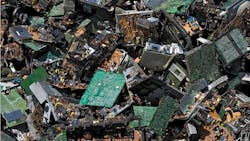Download this article in PDF format.
Any unwanted electronic device or cathode ray tube (CRT), e-waste is produced by households, businesses, governments and industries around the globe and often contains hazardous materials like lead and mercury. Plasma TVs, LCD monitors, laptops that include LCD monitors, printers, VCRs, cell phones and radios are just some of the main culprits that are adding to the world’s growing pile of e-waste.
As individuals, businesses and governments become increasingly dependent on technology, that pile of e-waste is growing at a similar pace. In fact, Waste Management World says e-waste ranks as the fastest-growing waste stream worldwide. According to the latest Global E-Waste Flows Monitor from the United Nations Institute for Training and Research (UNITAR), 53.6 million tonnes (Mt) of e-waste are currently being generated worldwide for an average of 7.3 kg per capita.
About 17% of that e-waste is managed in an “environmentally-sound manner” for a total of $9.4 billion in recycled iron, gold, copper and other valuable materials. What happens to the remaining 83% is unknown. “These 44.3 Mt might be treated or even recycled in an undocumented way or simply be dumped or burned, with a potential loss of $47.6 billion of raw materials,” WMW points out.
A Mounting Problem
The prospects for reducing e-waste aren’t encouraging at the moment. According to WMS, e-waste generation is expected to increase by an average of 2 Mt annually to 74.7 Mt in 2030 and as high as 110 Mt by 2050. In response to the current problem and these astronomical predictions, organizations and governments are looking for new ways to stem the flow of e-waste into the world’s landfills.
As one of the world’s largest electronics producers, Apple has rolled out numerous initiatives over the years, all of which were aimed at reducing e-waste. Its distributor and business partners are also getting into the e-waste reduction game. Most recently, a company based in Ireland began giving used Apple products a new life.
As reported in The Next Web, Alchemy is a “circular tech company” that streamlines the recovery, repair and resale of used devices like phones and laptops. The company’s trade-in program lets customers hand in their used Apple device and get a discount on a new one or a store credit.
“When you trade in an Apple device it’s Alchemy’s system that takes the title from the consumer, it’s us that has the second-hand dealer license, it’s us that receives it and ensures that it’s data safe,” the company’s CMO, James Murdock, told The Next Web. Once the devices are refurbished and priced, some are sold on Alchemy’s own marketplace Loop Mobile, which also operates on sites like Amazon, Walmart and Back Market.
The great thing about Apple products is that they hold their value better than any other tech brand, the publication reports. “Despite being a six-year-old phone, Alchemy still sells up to 15,000 iPhone 8’s a day.”
There’s Life Left in those Phones
Colleges and universities are also doing their part to help whittle away at the growing volume of e-waste being generated worldwide. At UC San Diego, for example, a group of researchers and students set out to find ways to tackle the 1.5 billion smartphones that are “junked” every year. Most of those phones have expended just 25% of their functional lifespans.
The research considers the practicality and environmental benefits of reusing processors (even from decade-old devices) for non-consumer applications, specifically as cloudlets for microservices for social media websites and as wildlife monitoring sensors. It also explores how to combine phones to perform increasingly complex tasks.
The UC San Diego research team also addressed how to make computing more sustainable, offering a metric, Computational Carbon Intensity (CCI), to enable quantified comparison of the true lifetime impact of computing.
“The team applied CCI to old servers, laptops and smartphones and found that smartphones offer the best potential for carbon impact,” the university reports. “Not only are there a remarkably large number of discarded phones available, but they come with a wide array of valuable components, including a robust power supply, networking hardware and, of course, powerful processors with plenty of utility remaining.”
Keeping it Out of the Landfill
E-waste reduction has found its way down to the individual state, county and city level throughout the U.S. This month, ERI offered residents in two Wisconsin counties the opportunity to “responsibly recycle” their unwanted consumer electronics via free e-waste collection events.
All types of residential electronic items were collected, including computer equipment, televisions, mobile devices and other electronics that contain batteries or electrical cords (with the exception of large household appliances).
“It is an honor to be able to bring responsible recycling of electronics to our friends in Sauk County and Marquette County and the surrounding areas,” said ERI’s John Shegerian. “The work we will be doing…will prevent unwanted electronics from ending up in landfills, while providing a convenient way for people to de-clutter.”
About the Author

Bridget McCrea
Contributing Writer | Supply Chain Connect
Bridget McCrea is a freelance writer who covers business and technology for various publications.






